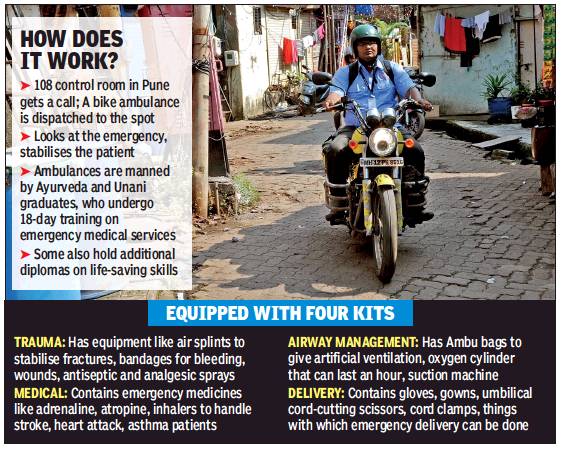BVG Emergency Medical Services
This is a collection of articles archived for the excellence of their content. |
In Mumbai
2018

From: September 29, 2018: The Times of India
One scene from the blockbuster ‘Three Idiots’ that remains etched on the mind has Aamir Khan on a bike carrying a sick man strapped to his back as he makes a dash for the hospital. A band of 18 bike-borne paramedics in Mumbai are now fighting such misconceptions while redefining the concept of emergency response.
Cut to a regular day: Ayurveda graduate Vijay Patil is at his post on the premises of a maternity hospital in northeastern Mumbai on Tuesday when his phone starts buzzing at 5.53pm. The caller informs him about a road accident outside a slum pocket nearby. “There could be an injured man, somewhere in the 40s,” the voice tells him. Patil revs up his Royal Enfield Thunderbird, which is equipped with a trauma kit, oxygen cylinder, manual ventilator and 30 types of emergency medicines, to lock down the situation.
In less than ten minutes, he reaches the spot to find an injured Vidyanand Mhatre
(42), sitting on the ground, bleeding from his right leg. Pushing the curious crowd aside, Patil opens his trauma kit to bandage the wound.
Mhatre says a biker hit him and fled the spot. Still in shock and shaken up, Mhatre asks Patil whether he could be transported to the nearest hospital on the two-wheeler. Patil gently informs him that bike ambulances are meant to stabilise and arrest further deterioration, not transport patients. He instead offers to call a backup ambulance.
“Often this is the first query. There is this misconception that patients would be riding pillion all the way to the hospital, which also makes many outrightly refuse our services. But things are steadily changing,” says Patil.
He’s part of an 18-member fleet that’s cut through the city’s gridlocked traffic and narrow roads to attend to 5,700 situations in Mumbai since the service was introduced in August last year.
Bike ambulances take less time, have better manoeuvrability
Maharashtra’s bikeborne response mechanism is part of the 108-free ambulance service run by BVG at an annual approximate cost of Rs 245 crore.
In Mumbai, where heart attack is the biggest killer, only three calls to bike ambulances were for cardiac emergencies, compared to over 3,000 calls for fever, abdominal pain, vomiting, loose motions. Dr Amol Pandit of BVG admits that the ambulance service remains under-utilised. “While we do get an average of four calls every day, its utilisation for real emergencies can be much more,” he adds.
Besides a response time of 9-12 minutes—half the time taken by a conventional vehicle ambulance—there have been advantages such as manoeuvering through crowds.
Ayurveda doctor Tejas Kamble, who mans one of the bike-ambulances posted in South Mumbai, recalled the day a fire broke out at Parel’s Crystal Tower and claimed four lives. “Ambulances struggled to reach the spot because of the crowd and TV crews, but we succeeded. We managed to rush patients to stationary ambulances, where they were put on oxygen support and applied cooling sprays on the way to hospital,” he says, adding they helped 16 of the injured.
However, he says, it’s time for citizens to understand and utilise EMS better. During mass casualties, enthusiastic helpers often snatch away stretchers or spine boards from them and rush to get patients. “They don't undestand that lifting a fracture patient the wrong way can cause lifelong damage,” he added.
As the EMS service matures, new complications related to delivering first-aid at the doorstep are also emerging. “Once we stabilise a patient, often the person doesn’t want to visit a hospital for a check-up,” said Abdul Basit, a 38-year-old Unani graduate from Malegaon, who has attended to cases of asthma attack, stroke and fractures.
He has turned down several requests of treating them with medicines available in the bike kit. He remembers the case of a 65-year-old diabetic woman who had become hypoglycemic after skipping breakfast. Basit started her on intravenous medicines and sugar medicines before persuading the family to take her to a hospital. He says, “Our job is to ensure a person reaches the closest hospital alive, not treat their condition.”
The world over, motorbike ambulances have done wonders. Studies have even credited their use in countries such as Sudan, Zambia and Malawi for bringing down mother and child deaths.